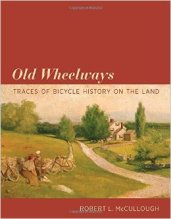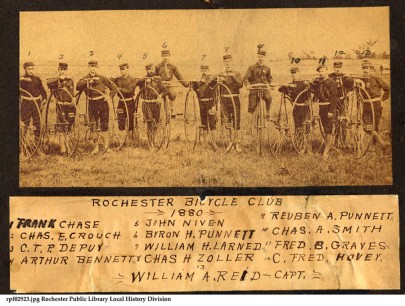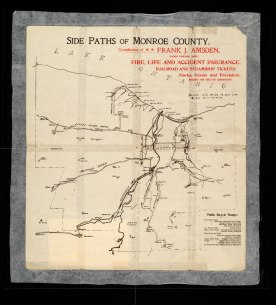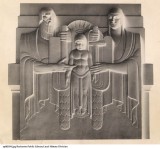Several months ago, the Local History & Genealogy Division was contacted by a historian from the University of Vermont who was preparing to publish a book and wanted permission to reproduce several photographs from the library’s collection. Late last week, the result of his work arrived in the mail, and I was excited to discover that Rochester features somewhat prominently in the book.
 Old Wheelways: Traces of Bicycle History on the Land, by Robert L. McCullough, explores the ways in which the late-nineteenth-century bicycle craze affected the American social and geographical landscape and the way people viewed it. As he writes in his preface, “For roughly two decades, from 1880 to 1900, bicycles and bicyclists shaped and reshaped American social, cultural, economic, and industrial history; introduced an independent and dependable means of overland travel; propelled a campaign to improve the nation’s pitiful network of roads; influenced the appearance of cities in subtle ways; swayed park planners; and set into motion the modern machine and engineering technology essential to the development of automobiles and airplanes” (xi).
Old Wheelways: Traces of Bicycle History on the Land, by Robert L. McCullough, explores the ways in which the late-nineteenth-century bicycle craze affected the American social and geographical landscape and the way people viewed it. As he writes in his preface, “For roughly two decades, from 1880 to 1900, bicycles and bicyclists shaped and reshaped American social, cultural, economic, and industrial history; introduced an independent and dependable means of overland travel; propelled a campaign to improve the nation’s pitiful network of roads; influenced the appearance of cities in subtle ways; swayed park planners; and set into motion the modern machine and engineering technology essential to the development of automobiles and airplanes” (xi).

Members of the Rochester Bicycle Club with their high wheels in 1880. From the collection of the Local History & Genealogy Division, Rochester Public Library.
Bicycles were first introduced to the American public at the Philadelphia Centennial Exposition in 1876. The earliest contraptions to attract popularity were high-wheel bicycles with a large front wheel and a small rear wheel of the type shown in the photo above.
By 1880, when the national League of American Wheelman (LAW) was established, the more recognizable safety bicycles of today were starting to come into vogue. With their two equal-sized wheels, they proved easier to manage. But one problem remained: Where to ride? One cyclist, reporting on a tour in 1894, noted that “the greatest difficulty for touring in new districts was to find suitable points to obtain meals, but on more than one occasion the group also had trouble finding its way, venturing along cow paths of dubious outcome, into thick woods, across fields of high weeds, or through deep pockets of sand” (x).

Map of Side Paths of Monroe County, 1900. From the collection of the Local History & Genealogy Division, Rochester Public Library.
This led bicycling clubs to lobby for better roads and, eventually, for designated bike routes. The Rochester Wheelman’s League formed for this purpose in 1892, and by early 1896 Monroe County’s first side path association was established. In 1898, county and city lawmakers approved a law authorizing creation of the government-run Monroe County Side Path Commission. The area’s cyclists had already built and opened 130 miles of bike paths with private donations, and five years later, in 1901, the county touted as many as 193 miles of side paths (161-62).
Although these paths are gone now, we are fortunate that a photographic record still exists. Sidepaths: Monroe County, a scrapbook of photographs taken by Cline Rogers, is preserved in the Local History & Genealogy Division. McCullough has reproduced many of these illustrations in his book, but you can also view the scrapbook online in the library’s digital collections: http://libraryweb.org/~digitized/books/Sidepaths_Monroe_County.pdf.
Robert McCullough, Old Wheelways: Traces of Bicycle History on the Land (Cambridge, MA: MIT Press, 2015). We are currently cataloging this book. Look for it soon in the Local History & Genealogy Division.
-Christine L. Ridarsky, City Historian & Historical Services Consultant

Leave a comment